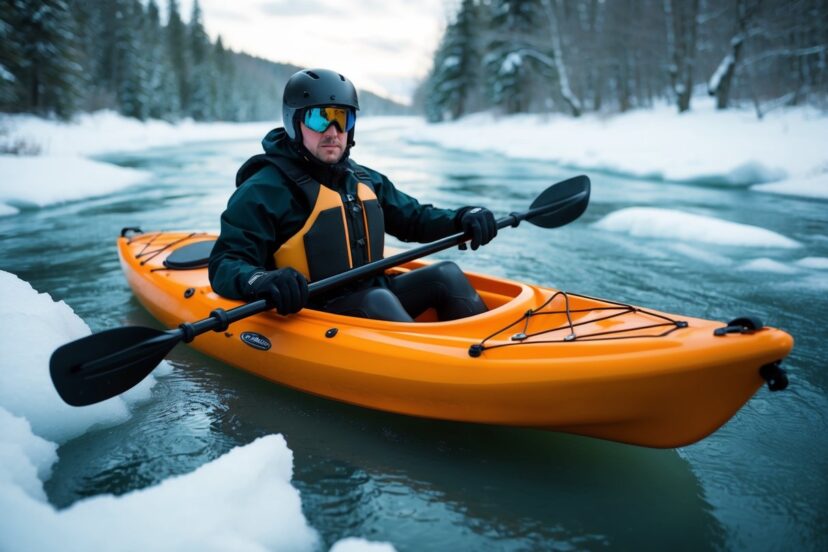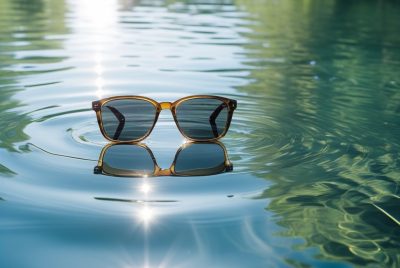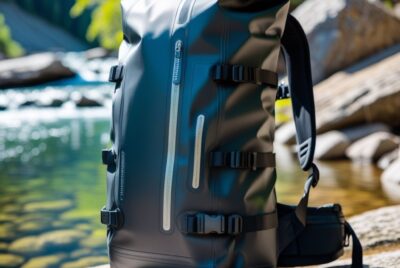Kayaking in Cold Weather: Essential Tips
*We may earn a commission for purchases made using our links. Please see our disclosure to learn more.
Kayaking in Cold Weather: Essential Tips for Safe Adventures
Kayaking in cold weather is both challenging and rewarding. I remember the first time I took my kayak out on a crisp winter morning, the landscape transformed by a dusting of snow, and the air sharp and invigorating. The experience was unlike any other, offering a sense of solitude and connection with nature. To safely enjoy cold-weather kayaking, it’s essential to have the right gear and knowledge.

Choosing the right clothing and equipment can make all the difference. Thick gloves and insulating layers provide warmth, while items like a spray skirt keep water out of the kayak. Safety is crucial, so I always ensure I’m prepared for the colder conditions. These preparations help in staying warm and comfortable, allowing me to fully enjoy the unique beauty of the season.
Kayaking in cold weather requires respect for the elements. I focus on being well-prepared and aware of the risks. By dressing appropriately and carrying the right gear, I can confidently set out on winter adventures, discovering the extraordinary calm and beauty that cold weather kayaking offers.
Understanding Cold Weather Challenges in Kayaking

Kayaking in cold weather offers unique challenges that require careful preparation. The cold can affect both the equipment and the kayaker. Being aware of these challenges helps me stay safe while enjoying the activity.
When the water temperature drops, wearing proper gear is crucial. I make sure to dress in layers and choose materials that insulate well. Neoprene and wool are great options. A dry suit can also provide extra protection in extremely cold conditions.
The risk of hypothermia is significant. Staying dry and minimizing time in the water is important. I keep an eye on my body and make sure I’m not pushing myself too hard. Safety is a top priority in these conditions.
Another challenge is navigation. Cold weather often brings strong winds and icy currents. I always check weather forecasts before heading out. Knowing the conditions helps me decide whether it’s safe to kayak that day.
I also pay attention to ice formations, which can be hazardous. They might block paths or create hazards that are difficult to see. My awareness of the surroundings keeps me prepared for unexpected obstacles.
Kayaking in cold weather requires advanced skills. It’s not recommended for beginners because of the increased risks involved. I ensure my skills are sharp and practice kayaking in calm, controlled environments before tackling more challenging ice-filled waters.
In cold conditions, preparation makes all the difference. With the right gear, skills, and mindset, kayaking in winter can be both safe and thrilling.
Essential Gear for Cold Weather Kayaking

Kayaking in colder conditions requires special gear to keep me safe and comfortable. Key essentials include clothing layers for insulation, suits to stay dry, buoyancy aids like personal flotation devices, and protection for my head and hands. These elements help combat the cold and ensure I’m prepared for any situation.
Insulation Layers
Wearing the right insulation layers is vital. Fleece base layers are excellent as they trap warmth and wick moisture. I avoid cotton because it retains water and can leave me chilled. My next layer could be a thermal top, providing a snug barrier against the cold. Layering allows me to adjust for specific weather and water conditions. I choose materials designed for activity, like those used in athletic wear. Maintaining flexibility and warmth is essential, and these materials ensure that. On particularly frosty days, I might add another layer, such as a wool or synthetic blend, for extra warmth.
Dry Suits and Wet Suits
Choosing between a dry suit and a wet suit depends on conditions. A dry suit is ideal when temperatures are near freezing, offering full waterproof protection and allowing for warm layers underneath. It keeps me dry in case of a capsize. In milder conditions, a wet suit might suffice. Wet suits provide insulation by trapping a thin layer of water between my skin and the suit, which my body heat warms. Both types should fit snugly but allow freedom of movement. For safety and comfort, I check the seals and zippers regularly to ensure they function properly and aren’t worn out.
Personal Flotation Devices
A Personal Flotation Device (PFD) is non-negotiable. It needs to be Coast Guard-approved, fitting well without restricting movement. A PFD provides buoyancy, crucial for safety in cold water, where impaired movement and shock responses are real dangers. I ensure that the PFD has adjustable straps to fit over my layers comfortably. Choosing a design with pockets or attachments for safety gear is beneficial. Features like reflectors add visibility in poor conditions, enhancing safety. In cold weather, wearing a PFD is even more critical, as colder waters increase risks of hypothermia and shock.
Head and Hand Protection
Protecting my head and hands is crucial against the chill. A neoprene or wool hat offers insulation, keeping warmth from escaping through my head, a significant heat loss point. It should resist water while providing enough coverage. For my hands, neoprene gloves or mittens offer dexterity and warmth. If paddling conditions turn harsh, pogies (covers that attach to the paddle) provide added protection, letting me grip the paddle directly while insulated. Attention to small details like these can make a big difference in overall comfort and safety during a cold-weather paddle.
Cold Water Safety and Hypothermia Prevention

When kayaking in cold weather, it’s crucial to pay attention to safety and prevent hypothermia. Recognizing signs early and knowing emergency actions can save lives. Staying informed and prepared for cold conditions enhances the kayaking experience.
Recognizing Hypothermia Symptoms
Hypothermia occurs when the body loses heat faster than it can produce it. This can happen even in water above freezing. Mild symptoms start with shivering and cold, pale skin. As it progresses, you might notice confusion, slurred speech, and decreased coordination.
In more severe cases, shivering can stop, the pulse might weaken, and consciousness can be lost. It’s important to stay vigilant, learning the signs can significantly reduce risks. Being aware of body reactions helps respond swiftly and effectively.
Emergency Procedures
If someone shows hypothermia symptoms, swift action is essential. Move the person out of the cold and wind. If possible, remove wet clothing and cover the person with dry, warm layers, focusing on the head and torso.
Provide warm, non-alcoholic beverages if the person is conscious. You can also use warm, dry compresses on major arteries, like the neck or groin. Avoid direct heat like hot water or heating pads, as they can cause shock.
It’s key to get medical help as soon as possible. Emergency procedures bridge the gap until professionals can take over. Proper strategies can minimize harm and improve recovery chances.
Kayaking Techniques for Cold Conditions

Kayaking in cold weather demands specific skills to ensure safety and efficiency. Strategic paddling and energy management are essential for enjoying your time on the water while staying warm and safe.
Paddling Strategies when Kayaking in Cold Weather
When kayaking in cold conditions, I focus on using efficient paddling techniques. The forward stroke is crucial. I maintain a smooth and rhythmic pattern to save energy. It’s important to use my core muscles, not just my arms, to keep paddling powerful yet sustainable.
I practice staying relaxed, which keeps me more balanced in rough conditions. Keeping a low angle stroke helps in windy conditions. This technique minimizes exposure to the elements and conserves warmth by blending purpose and ease into my paddling.
Managing Energy and Stamina
In cold weather, managing my energy is essential. I start with a warm-up to activate my muscles and get my blood circulating. Dressing in layers helps regulate body heat, and I ensure they are breathable to prevent sweating, which can lead to chilling.
I pay attention to my food intake, opting for snacks rich in carbohydrates and proteins, as they provide quick energy. Hydration is just as critical, so I keep water accessible, as staying hydrated helps maintain my energy levels. Ensuring regular breaks also prevents fatigue from setting in too quickly.
Planning and Preparing for Cold Weather Paddling

When kayaking in cold weather, careful planning is essential. You should select your route wisely, check weather conditions, and ensure you have a safety checklist in place. These steps will help keep your adventure both safe and enjoyable.
Route Selection
Choosing the right route for winter kayaking is important for safety and enjoyment. I focus on areas I know well, opting for waters that suit my skill level. It’s important to avoid routes with strong currents or known hazards.
I plan shorter trips in colder months to reduce exposure to harsh conditions. It’s better to paddle near the shore or in calmer waters where help is closer if needed. I also use maps or GPS to ensure clear navigation and avoid getting lost. Having an alternate route is smart, as weather and water conditions can change quickly. Being prepared with a backup plan ensures I’m ready for any unexpected changes.
Weather Forecasting
Checking the weather forecast before heading out is a key part of my preparation. I monitor temperatures, wind conditions, and any potential storms. It is vital to understand how sudden drops in temperature can affect the water and my equipment.
I sometimes rely on multiple reliable sources for weather updates. Knowing the tidal patterns and potential wind speed helps me plan better. If the forecast suggests severe conditions, it’s best to postpone the trip. Knowing the sunrise and sunset times ensures I kayak only during daylight to avoid added risks. It’s all about being aware and adaptable.
Safety Checklists when Kayaking in Cold Weather
Having a safety checklist ensures that I’ve considered every aspect of my trip. I start with the gear: a drysuit or wetsuit keeps me warm, while layers of non-cotton, insulating, moisture-wicking clothing provide protection. I always include a warm hat and gloves.
My safety checklist includes a communication device, like a fully charged phone or a marine radio. A whistle and a small first-aid kit are also essential for emergencies. Before leaving, I share my plan with someone I trust, including my route and expected return time. This adds an extra layer of safety, ensuring someone knows my location if things don’t go as planned.
Environmental Considerations and Ethics
Kayaking in cold weather involves understanding how my presence can affect natural environments and adhering to principles that minimize impact. It is important for me to be mindful of both ecosystems and ethical practices.
Impact on Ecosystems
Kayaking brings me close to wildlife and natural areas, so I must consider how my actions affect these delicate ecosystems. Cold weather can make wildlife more vulnerable. I need to avoid disturbing animals, steer clear of nesting sites, and respect wildlife spaces. Ecosystems rely on their natural balance, and even small disruptions can have long-term effects.
I should also be aware of the potential for water pollution. Equipment and gear should be checked for any substances that might contaminate the water. Careful planning helps prevent unintended harm.
Leave No Trace Principles
Following Leave No Trace principles is important in all environments, but especially in cold-weather kayaking. These principles guide me on how to enjoy nature responsibly. Planning ahead ensures I am prepared and minimizes unplanned reactions. Staying on durable surfaces, like established trails and campsites, reduces my impact.
I must pack out all trash, including biodegradable waste, to prevent environmental degradation. Practicing respectful behavior by observing but not interacting directly with wildlife reduces stress on animals. By being mindful of these principles, I contribute positively to preserving natural areas for future enjoyment.
Frequently Asked Questions
Cold weather kayaking requires careful preparation to stay safe and comfortable. From the right gear to understanding risks, these questions address key considerations.
1. What essential gear should be worn for kayaking in cold climates?
When kayaking in cold climates, I always wear a wetsuit or drysuit, thermal layers, a waterproof jacket, gloves, and a hat. A spray skirt helps keep water out, and a dry bag ensures my valuables stay dry. This gear keeps me warm and safe in chilly waters.
2. How does the ‘cold water rule’ apply to winter kayaking safety?
The ‘cold water rule’ is crucial for safety when kayaking in winter. It’s advised to wear protective clothing if the combined air and water temperature is under 120 degrees Fahrenheit. By following this rule, I ensure that I’m well-protected against hypothermia and other cold-related risks.
3. What should kayakers consider when planning a trip in chilly weather conditions?
Before heading out, I carefully check the weather forecast and water conditions. I plan my route, inform someone of my itinerary, and choose locations suitable for winter conditions. Being prepared with emergency gear and knowledge is key to handling any situation.
4. Which are the recommended types of suits for kayaking during the winter season?
For winter kayaking, I recommend choosing a drysuit or a wetsuit based on water temperatures. Drysuits are best for very cold conditions, as they keep me dry and warm by allowing me to layer underneath. Wetsuits provide insulation by trapping a thin layer of water against the skin.
5. At what temperature range is it deemed unsafe to go kayaking?
Kayaking becomes unsafe when water temperatures are below 60 degrees Fahrenheit, especially without appropriate gear. For air temperatures, I avoid kayaking when they’re extremely low unless properly equipped. Being aware of both air and water temperatures is vital for safety.




